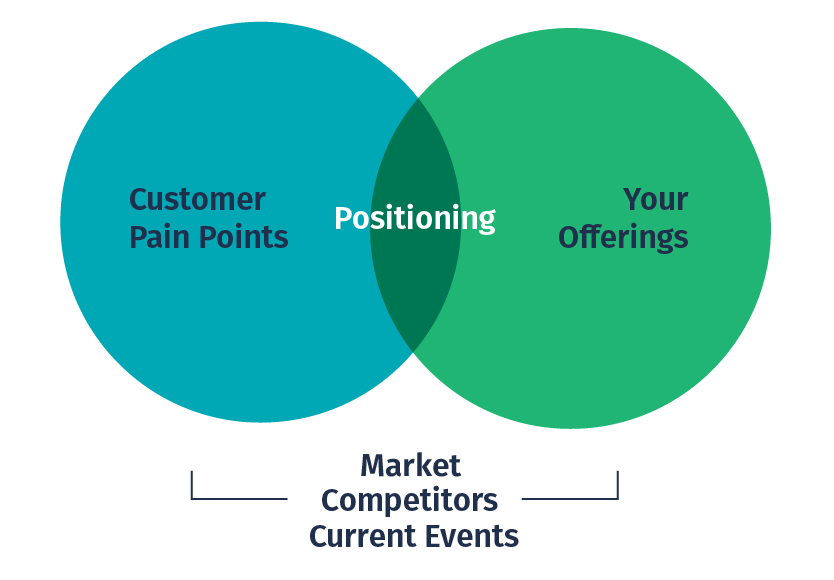It’s a noisy, saturated market out there. Every day we are inundated with information – text messages, emails, LinkedIn ads, TikTok videos, whitepapers, newsletters, billboards, the list goes on. We’re told to buy this, do this, think this. Last year more than 1 billion hours of new content was introduced online, and that is going to get even worse with the advent of generative AI in sales and marketing.
As someone selling a service, how do you compete with it all? Where do you even begin to compete with it all? Hint: it might not be where you think.
When someone is making a decision to buy, you may be inclined to think it’s driven by facts and rationale. However, more often than not, there’s something much deeper at play. Buying decisions are also driven by an emotional connection that an individual feels to a brand, past experiences and more.
Your company’s positioning is a big piece of both the rational and emotional connection you have with customers.
What is positioning and why is it important?
Positioning is essentially the meeting point between your customers’ pain points and your unique solution to their problems. It’s the messaging you take to market that defines and differentiates your company; it separates what you do from all the other noise out there.
Developing great positioning isn’t easy. It’s not something you can type into ChatGPT and out comes the perfect answer. It requires insight, outside-in thinking and perhaps most importantly, making choices. This is partly why positioning is so daunting to companies and leaders. Because it puts a box around what you do and who you serve. It informs employees, partners and customers about how they should view you.
However, the right positioning is an accelerant. It makes it easier for the people who you want to connect with to more clearly understand what you do, why they need you and why they should work/engage/buy from you over someone else. In a world where people are inundated with so much information, that clarity goes a long way. The companies and solutions that are everything to everyone will just get lost in the noise.
The best positioning can be found at the intersection of two elements: 1) your unique offerings and 2) Your customer pain points
And it’s influenced by three things: 1) the market; 2) competitors; 3) current events

Where do I start with positioning?
When developing your positioning, the best place to start is with your customers. Your customers hold the answers you’re looking for: what they want, need, why they buy from you and why they don’t. You need to get those answers. A word to the wise: you may think you know what your customers want and need, but it’s important to go beyond assumptions and talk to them directly. This will help you sell more, scale more, land better accounts, and truly differentiate yourself from others who may be making similar pitches.
Start by identifying the specific segments of customers you’re trying to reach. Not all customers are exactly the same. In the B2B world, you could break this down by industry, company size, departments or functions, and role. Narrow it down to between two and four segments. It won’t be easy but part of this exercise is to prioritize and create clarity, and if you have 10 different segments, that’s not prioritizing. Try to target multiple customers from each segment so you can see patterns and consistencies versus one-off outlier situations.
When developing your positioning, the best place to start is with your customers. Your customers hold the answers you’re looking for: what they want, need, why they buy from you and why they don’t.
The best approach to get solid input from your customers is through one-on-one interviews. If you’re looking to reach a broader group of people, a survey can be helpful, but it’s not as effective as live conversations where you can see people’s emotional reactions and dig deeper.
For customer interviews, it’s tempting to have the sales person or account owner manage the interview. However, it works best to have someone a bit more objective (and less inclined to try and sell), such as an executive or an agency or consultant (if you can afford one). This process takes time. Don’t rush it.
The questions you ask should cover emotional and rational topics, such as:
- What keeps you up at night when it comes to your job?
- How did you hear about our company?
- Why did you choose us over _______?
- What made you trust us?
- How are we making your life easier?
- How would you describe what we do in 2-3 sentences?
Take a look around before you get started
Once you’ve completed your interviews and have identified key themes, it’s time to combine those insights with some market research, a competitive analyses, and a review of current events. This will help ensure your positioning is both relevant and differentiated.
A market analysis can help identify where there is white space or gaps in the market, or where it’s oversaturated. A competitive analysis can give you context for how others are positioning themselves so you can more clearly articulate why customers should choose you over someone else. Surveying current events can help you avoid potential landmines, and fit what you’re offering into your customers’ current priorities.
With that being said, truly innovative companies are often ahead of the market and their positioning will reflect that. Their positioning won’t always hinge on what others are doing or saying at the time, which is why this element should be secondary to your customers and offerings.
Develop the positioning and messaging
Once you have the foundation in place, you’re ready to write your positioning. Whether you’re focused on corporate positioning or solution positioning, it should be:
- Different
- Cohesive
- Simple
- True to the brand mission and values
- Connected to customer needs
There are many different templates available to help put pen to paper (or hands to keyboard) but all positioning should include:
- A main value proposition
- The pain points you’re addressing
- The value/benefit you bring to customers
- Key differentiators
- Your approach
- The industries or verticals that you specialize in (if applicable)
Make sure you focus on the value and benefit you’re delivering, not what you are doing/selling. It’s not about “integrating Salesforce” or “migrating to a new cloud data warehouse”, it’s about what problem you are solving and the outcome of what you do. How are you making their lives easier? Are you saving them time by automating a piece of their work so they don’t have to work nights and weekends? Are you helping them look good to their superiors?
When in doubt, dig deeper.
How do you know if the positioning resonates?
It’s important to test your positioning prior to rolling it out across a company, and to refine it along the way. Your position in the market is constantly evolving, just as markets and customer expectations evolve.
Before rolling it out, test it with a few of your best salespeople or customer success leaders. Make sure it doesn’t just sound good, but reflects what the product or services actually deliver. When it’s used in a sales pitch, do customers’ eyes light up? Can people remember what you do and identify similar differentiators? If not, chances are the positioning may be off. If that’s the case, go back and talk to your customers.
Once you’ve made a commitment to that positioning, test slight variations of it on your website, with ads or at events. Which versions are people responding to or interacting with the most? Check in with salespeople where the positioning is actually helping to accelerate conversations, or where it’s falling flat.
Ultimately, great positioning will make it very clear who you help, how you help them and why you are a better choice than other options. That clarity will not only make it easier for customers to buy, but also for your team to sell. It will provide a level of consistency that will help a brand break through and take root. And if you take the time to really get to know your customers, you won’t just be well positioned to make a sale, you’ll create lifelong relationships in the process.


